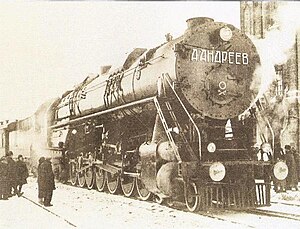SŽD series АА 20
| AA20-1 | |
|---|---|
|
AA20-1 1935
|
|
| Number: | 1 |
| Manufacturer: | Voroshilovgrad Locomotive Factory |
| Year of construction (s): | 1934 |
| Retirement: | 1960 |
| Type : | 2'G2 'h2 |
| Gauge : | 1524 mm |
| Length over coupling: | 33,730 mm |
| Height: | 5247 mm |
| Fixed wheelbase: | 10,050 mm |
| Total wheelbase: | 17,320 mm |
| Service mass: | 208.0 t |
| Friction mass: | 140.0 t |
| Indexed performance : | 2723 kW |
| Starting tractive effort: | 300 to 320 kN |
| Coupling wheel diameter: | 1600 mm |
| Impeller diameter front: | 760 mm |
| Rear wheel diameter: | 1050 mm |
| Number of cylinders: | 2 |
| Cylinder diameter: | 740 mm |
| Piston stroke: | 810 mm |
| Boiler overpressure: | 17 bar |
| Grate area: | 12.00 m² |
| Tubular heating surface: | 448 m² |
| Superheater area : | 174 m² |
The locomotive AA20-1 the Soviet railways was the world's only steam locomotive with seven coupled axles in a rigid frame .
history
To increase the power of a steam locomotive, it is necessary to use a larger boiler . However, this also requires a higher axle load . This problem can be countered by distributing the load over several axes . The use of articulated locomotives of the Mallet or Garratt design meant a higher technological and maintenance expense than locomotives with a rigid frame due to the moving parts and the flexible steam lines.
The railways in the Soviet Union were in the late 1920s with the problem of the limited 20 tons axle load tracks the ever-increasing freight to cope.
In addition to testing the Series Baureihe Garratt locomotive , a group of young engineers at the Moscow Institute for Railway Engineers developed a locomotive with a 1'G2 ' wheel arrangement in 1931. The blueprints for the design went to the Voroshilovgrad locomotive works . There, the design was further developed into a 2'G2 'locomotive in order to achieve the intended axle loads. It was planned to build two prototypes of the vehicle .
The AA 20-1 was completed in 1934 and transferred to Moscow on January 1, 1935 . The locomotive reached a speed of 40 km / h with a 2800 t train on an incline of 10 ‰. A power of 2723 kW was indicated and a starting tractive effort of 300 to 320 kN was determined. The locomotive was named after Andrei Andreev .
However, the locomotive turned out to be a total bad design. In addition to some design flaws, the track system was damaged by the long, fixed wheelbase , the locomotive derailed on points and the turntables and stands also proved to be too short. Since the decision has now been made to design the routes for an axle load of 23 t through modernization measures, the further development of the locomotive was no longer necessary. The locomotive was then parked in Shcherbinka and is said to have only been scrapped in the 1960s.
Constructive features
The engine had a bar frame having a front ALCO - bogie and a rear bissel .
The boiler was designed for a pressure of 17 bar. The fire box was equipped with a stoker for mechanical firing and a combustion chamber. The steam superheater was of the Chusov type. The two-cylinder steam - engine worked on the fourth coupled axle.
To reduce the pin and bearing loads, the coupling rod was designed in tandem. The front four axles were connected by a coupling rod, as were the three rear axles. The fifth axis was connected to the coupling axis by means of an articulated tandem rod.
The front bogie had an additional side play of ± 145 mm and the rear of ± 265 mm. The first coupling axle had a side play of ± 27 mm, the third to fifth sets of axles were without a flange and the last wheel set had a side play of ± 35 mm.
The locomotive was equipped with a six-axle bogie Tender coupled. With a service weight of 125 t, this had a capacity of 52.5 m³ of water and 24.5 t of coal.
literature
- Raimar Lehmann: Steam locomotive special designs . 2nd unchanged edition. Verlag Technik, Berlin 1987, ISBN 3-341-00336-3 , p. 12 .
- Vitaly Alexandrowitsch Rakow: Russian and Soviet steam locomotives . transpress, Berlin 1986, ISBN 3-344-00060-8 , pp. 187 ff .
- Adolph Giesl-Gieslingen: Locomotive athletes - history, performance and cornering of the six and seven couplers . Slezak Verlag, Vienna 1976, ISBN 3-900134-27-8 , p. 239 ff. + images .
Web links
- Russian Reforms on The Self Site (English)
- AA-20 on Gunter's Locomotive Pages (English)
